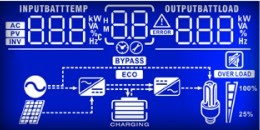
Due to electricity energy crises in Pakistan, the alternate power energy solutions are highly required, people are also looking for alternate energy sources.
As solar is one of the best alternate power energy source, so investing in it will be profitable in future, Pakistan is the country which is blessed with super solar energy, thus; it ts the need of time to plan to harvest this natural energy properly.
Coming straight to the point, Solar inverters or Hybrid inverters, are designed to use the solar energy source as well as utility source (WAPDA). In this guide you will know about the working, settings, setup and installation of Hybrid Solar Inverter.
Working / Design:
Two main categories of hybrid inverters are Grid-Tie Solar Inverter and Off-Grid Solar Inverter. We are discussing about the Off-Grid solar inverter because they are simple and a wide variety of them are available in local market.
They are sub-categorized into modified sine wave inverter (low cost) and pure sine wave inverter (their cost is high). If you need to run motor load such as Water Pump, AC, Fridge or other types of appliances which contains compressor / motor then Pure-Sine-Wave inverters are recommended. For Fans, Air Coolers, Fluorescent Lamps (Energy Savers), Bulbs and Tube Lights Modified-Sine-Wave will also work.
Working and design of Hybrid Inverters are same as normal Inverter / UPS, the only difference is that their input supports more than one source such as Battery, Main (WAPDA), Generator or Wind Turbine.
In the settings or menu you can configure the priority of input source: such as Solar First, (WAPDA) Utility First or Solar and (WAPDA) Utility Source. The setting of charging source for Battery: Charge Battery from Solar only, Charge Battery from (WAPDA) Utility only or the combination of both.
------------------------------------------------------------------------------------------------------
Detailed information about inverter / ups: How Inverter / UPS Works
------------------------------------------------------------------------------------------------------
Installation of Hybrid Inverter:
The installation work is not complex but to avoid the risk of any kind always consult concerned personnel.
The installation work includes following:
- Solar Sizing
- Load Calculation
- Battery Sizing
- Back-UP Time
- Protectors, Circuit Breakers
- Wiring (AC & DC)
- Earthing
Hybrid Inverter Settings:
Hybrid Solar Inverter provides you the options to configure the device according to your requirement.
The typical setting options that almost all Hybrid Inverter provides are:
Source Priority:
The is the most important step in configuring any Hybrid Solar Inverter. Solar, WAPDA and Battery are the three types of available sources, choose them accordingly.
For Output Load
- Power the Load from Solar
- Power the Load from Main (WAPDA)
- Power Load the from Both
- Charge Battery from Solar Only
- Charge Battery from Main (WAPDA) only
- Charging Battery with combination of both
- Low battery Cut-Off Voltage
- Battery Type: (Lead-Acid Battery) Flooded, GEL, AGM
- Float Charging Voltage
- Charger Cut-Off Voltage
These settings need proper concentration and professional skills.
-------------------------------------------
Also Read: How to run AC on UPS
-------------------------------------------
Yes you can RUN AC, Fridge, Iron, Fans, Lights, TV, Washing Machine, Water PUMP or any other electric appliance with solar power.
Power Saving:
Power, Energy or Cost Saving is the point for which i have explained all above.
Solar is not cheap than WAPDA
Yes, that's true, due to high cost of Deep-Cycle Batteries and Solar Batteries in Pakistani market, solar energy will cost you more than WAPDA (the Main or Utility provider in Pakistan).
Just assume you have installed 500-Watt Solar System with back-up time (12-hour in case of stand-alone solar system and 3.5 hour in case of hybrid solar system) and your inverter's efficiency is above 85 percent.
For 500-Watt stand-alone solar system you need minimum 600-Amp Battery Bank (four Batteries of 150-Amp each) and to charge this battery bank and to provide the power to connected load in day, if sun is available for 10-hour (assuming 7-AM to 5-PM for summer in Pakistan), you need minimum 900-Watt A-Grade solar panels. Enjoy power holidays in cloudy weather!
To run the same load with Hybrid Solar Inverter, 200-Amp Battery bank (two batteries of 100-Amp each) is must and to charge the battery bank and to provide the power the connected AC load at same time minimum 900-Watt solar panel is needed. Charging of Battery with generator or WAPDA source in cloudy weather.
Long backup time needs more batteries
Now just calculate the cost of Batteries in both cases. 150-Amp deep cycle dry battery will cost you Rs. 26,000/- approximately. If your system is designed and installed by qualified professionals your battery bank may lasts for more than four years. For stand alone system only the battery bank will cost you more than Rs. 110 per day for stand (including cloudy days and short sun time in winters).
----------------------------------------------------------------------------------------------------
Read Full Article: Solar vs WAPDA
Is Solar Power Costs you lower than WAPDA or Main ? Calculation says No !
----------------------------------------------------------------------------------------------------
For hybrid system the cost you save from batteries will payable to WAPDA for charging the batteries in night or in absence of Sun.
On the other hand, one unit of WAPDA's costs you Rs. 8 (with subsidy including taxes). To run the same load (500-watts continuously run for 24-hours) on WAPDA for 24-hours will cost you Rs. 96 per day.





No comments:
Post a Comment